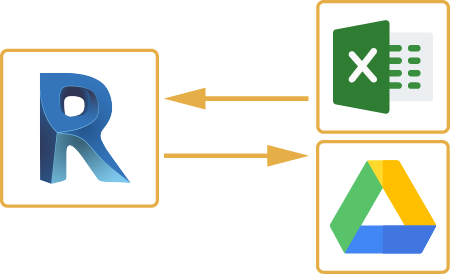Elevate Your Revit Experience with Important Revit Tools and Add Ins
Wiki Article
Understanding the Art of Data Integration: Exactly How to Seamlessly Import Excel Files Into Revit
Are you having a hard time to import Excel data right into Revit smoothly? Look no more! In this short article, we will certainly lead you via the process of understanding the art of information assimilation. Discover the significance of seamless combination in Revit and discover the Excel data format for Revit assimilation. Prepare to prepare your Excel data effortlessly and follow our step-by-step guide to import documents into Revit. With our best techniques, you'll accomplish data integration success in no time at all. Let's begin!Recognizing the Significance of Data Combination in Revit
Recognizing the relevance of data integration in Revit is crucial for seamless importing of Excel files. It permits you to efficiently handle and update details throughout the entire job when you incorporate information from Excel into Revit. This integration guarantees that your design and building and construction procedure is exact and current.By incorporating information, you can conveniently import and update criteria, timetables, and also geometry in Revit. This removes the need for hand-operated information entry, conserving you time and decreasing the threat of errors. With Revit's data combination capacities, you can keep uniformity and precision in your job, while also improving cooperation amongst staff member.

Checking Out the Excel Data Layout for Revit Integration

In order to effectively incorporate Excel files into Revit, it is vital to guarantee that the information is formatted correctly. This includes appropriately classifying columns and rows, as well as structuring the information in a manner that is suitable with Revit's data schema. Revit makes use of specific criteria and classifications to arrange data, so it is very important to straighten the Excel information with these criteria to make sure a seamless integration.
In addition, it is essential to note that Revit only sustains particular data kinds when importing from Excel. These consist of text, numbers, and days. Any kind of other data kinds, such as solutions or conditional formatting, will certainly not be identified by Revit and might create problems throughout the assimilation procedure.
Preparing Your Excel Information for Seamless Import Into Revit
To make sure a smooth integration procedure, you'll require to effectively layout and label the columns and rows in your Excel information prior to importing it right into Revit. This step is crucial since it enables Revit to accurately interpret and organize your data. Beginning by analyzing your Excel information and identifying which rows and columns consist of appropriate information for your Revit job. Then, make certain to identify each column with a clear and detailed header. This will certainly assist you and others conveniently understand the objective of each column and stay clear of confusion during the import procedure.Following, make certain that the information in each column is effectively formatted. If you have a column for dimensions, make sure that all dimensions are continually formatted in the same devices of measurement. Revit depends on consistent formatting to properly interpret and import information.
Furthermore, it is vital to inspect for any kind of empty cells or variances in your information. Revit may not have the ability to check out or import data from cells that are empty or include mistakes. It is suggested to review your Excel data and clean up any type of variances before importing it into Revit.
Step-By-Step Guide to Importing Excel Files Into Revit
When you have actually effectively formatted and identified your Excel information, you can conveniently import it right into Revit by following this step-by-step guide. To begin, open Revit and browse to the "Insert" tab. revit tools.Following, a dialog box will certainly appear, permitting you to personalize the import setups. Below, you can select the worksheet you intend to import, define the variety of cells to import, and select the proper devices for your data. As soon as you have actually made your choices, click "OK" to proceed.
Revit will certainly currently present a sneak peek of your Excel data. Take a minute to assess the sneak peek and make certain that everything looks proper. If needed, you can make modifications to the import setups by clicking the "Settings" switch.
Best Practices for Information Integration Success in Revit
Make certain you follow these finest practices to make certain successful integration of data in Revit. It is essential to organize your information in Excel prior to importing it right into Revit. Be conscious of the units and data types when mapping the information, as any kind of disparities can lead to errors in the assimilation procedure.Another important practice is to on a regular basis confirm and update your data. Additionally, make use of data validation devices within Revit to determine any kind of errors or disparities in the integrated information.
Lastly, it is advised to establish a clear process for information integration. This includes defining obligations and roles, setting up an interaction channel in between employee, and developing a routine tempo for data updates and testimonials. By following these finest practices, you can ensure a seamless and successful integration of information in Revit, eventually enhancing the performance and precision of your job.
Verdict
Finally, understanding the art of data assimilation is vital for seamless More Help import of Excel files into Revit. Comprehending the relevance of information integration in Revit is the very first step in the direction of successful integration. Checking out the Excel documents style for Revit assimilation aids in recognizing the requirements and page limitations. Preparing the Excel information appropriately and following a step-by-step overview is crucial for a smooth import procedure. By complying with ideal practices, you can make certain information integration success in Revit and make one of the most out of your job.When importing information from Excel right into Revit, it is vital to understand the documents layout and just how it can influence the combination process (import excel into revit). Revit uses details parameters and groups to organize data, so it is important to align the Excel information with these criteria to make sure a seamless integration
Be mindful of the information and systems types when mapping the information, as any type of disparities can lead to errors in the integration procedure.
Additionally, make usage of information validation tools within Revit to identify any type of errors or incongruities in the incorporated information.

Report this wiki page